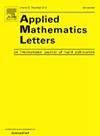保能二次算子的表示及其在算子推理中的应用
IF 2.8
2区 数学
Q1 MATHEMATICS, APPLIED
引用次数: 0
摘要
本文研究了保能二次算子的偏对称参数化。此前,[Goyal等人(2023)]提出了这种参数化,以在非侵入式模型约简中加强二次项的能量保存。我们在此证明了每一个能量守恒二次项都可以通过斜对称矩阵块的对应算子的参数化来等价地表示。在给定任意保能算子的情况下,提出了一种计算具有偏对称子矩阵的等价二次算子的算法。因此,对于具有保能非线性的系统,我们在非侵入性降阶建模(ROM)的框架中,通过算子推理(OpInf),采用了偏对称子矩阵表示。为此,我们提出了一个顺序的线性最小二乘(LS)问题的推理任务公式,以确保数据驱动的二次算子的能量守恒。一维Korteweg-de Vries方程和二维Burgers方程基准的数值结果表明了这种方法的潜力;推导出的系统动力学是准确的,而相应的算符忠实于系统的基本物理性质。本文章由计算机程序翻译,如有差异,请以英文原文为准。
On the representation of energy-preserving quadratic operators with application to Operator Inference
In this work, we investigate a skew-symmetric parameterization for energy-preserving quadratic operators. Earlier, [Goyal et al. (2023)] proposed this parameterization to enforce energy-preservation of quadratic terms in non-intrusive model reduction. We here prove that every energy-preserving quadratic term can be equivalently formulated using a parameterization of the corresponding operator via skew-symmetric matrix blocks. We develop an algorithm to compute an equivalent quadratic operator with skew-symmetric sub-matrices, given an arbitrary energy-preserving operator. Consequently, we employ the skew-symmetric sub-matrix representation in the framework of non-intrusive reduced-order modeling (ROM) via Operator Inference (OpInf) for systems with an energy-preserving nonlinearity. To this end, we propose a sequential, linear least-squares (LS) problems formulation for the inference task, to ensure energy-preservation of the data-driven quadratic operator. The potential of this approach is indicated by the numerical results for a 1D Korteweg–de Vries and a 2D Burgers’ equation benchmark; the inferred system dynamics are accurate, while the corresponding operators are faithful to the underlying physical properties of the system.
求助全文
通过发布文献求助,成功后即可免费获取论文全文。
去求助
来源期刊

Applied Mathematics Letters
数学-应用数学
CiteScore
7.70
自引率
5.40%
发文量
347
审稿时长
10 days
期刊介绍:
The purpose of Applied Mathematics Letters is to provide a means of rapid publication for important but brief applied mathematical papers. The brief descriptions of any work involving a novel application or utilization of mathematics, or a development in the methodology of applied mathematics is a potential contribution for this journal. This journal''s focus is on applied mathematics topics based on differential equations and linear algebra. Priority will be given to submissions that are likely to appeal to a wide audience.
 求助内容:
求助内容: 应助结果提醒方式:
应助结果提醒方式:


